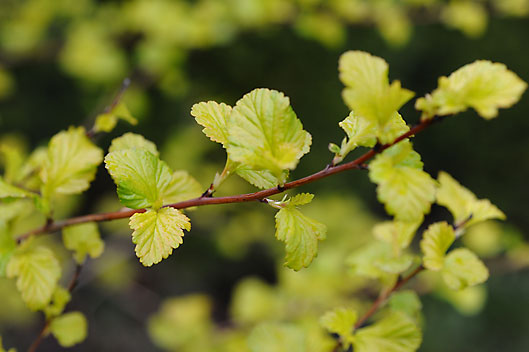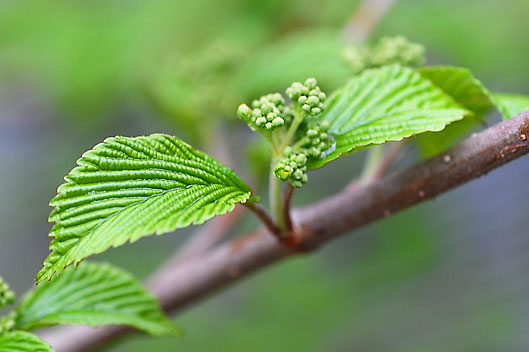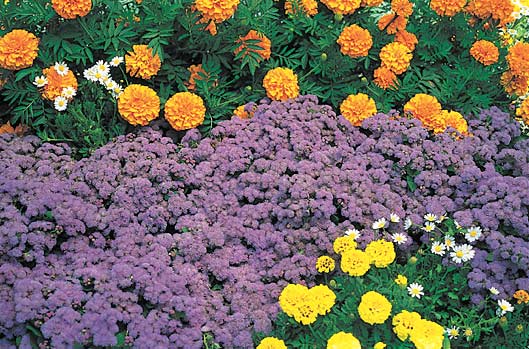 W. Atlee Burpee & Co.
W. Atlee Burpee & Co.
‘Blue Danube’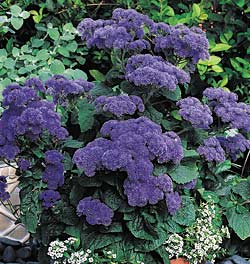 Goldsmith Seeds
Goldsmith Seeds
‘Leilani’by George Papadelis
In recent years, the most popular annual bedding plants have experienced enormous breakthroughs that have helped them continue their domination of the market. Impatiens, begonias, marigolds, salvia, petunias, verbena, and pansies have been improved with more colors, different sizes, some double flowers, and, especially, better garden performance. Ageratum or floss flower is no exception. In the last seven or eight years, new colors and sizes have made this popular bedding plant even more valuable in the sunny landscape.
Years ago, the only readily available variety was ‘Blue Danube’ which was also called ‘Blue Puff.’ It had clusters of clear blue, “puffy” flowers on plants about 7 inches tall. The first significant improvement came with the Hawaii series. It offered more compact plants (6 inches tall) and more vibrant colors in ‘Blue,’ ‘Royal’ (violet), ‘Shell Pink,’ and ‘White.’ ‘Hawaii Royal’ is a new, improved color and ‘Hawaii Shell Pink’ is new for 2002. ‘Hawaii Blue’ is very popular in mass plantings or as an edging plant since few low-maintenance, compact plants are available in a true blue color.
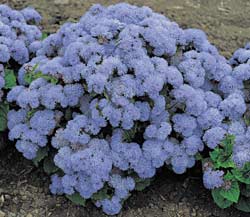 Goldsmith Seeds
Goldsmith Seeds
‘Neptune Blue’Ageratum ‘Blue Horizon’ changed everything. Instead of being more compact and suitable for edging, this one was a towering 24- to 30-inch bush of blue flowers. Gardeners began using Ageratum in different ways and realized its potential as a bright blue centerpiece or focal point that was great for annual beds. Perennial gardeners plant it among perennials as an all-summer blooming source of blue that blends perfectly with yellows, pinks, and purples. In fact, this taller variety resembles the perennial ageratum (Eupatorium coelestinum) but boasts several advantages for the gardener. It costs less, it blooms all summer, it is never invasive, and overwintering is not an issue. Its long stems allow this one to be used as a long-lasting, blue cut flower as well.
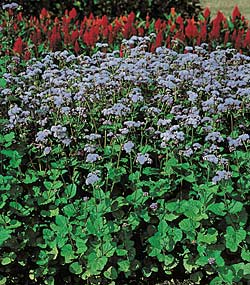 W. Atlee Burpee & Co.
W. Atlee Burpee & Co.
‘Blue Horizon’‘Red Top’ is a rich, burgundy-red whose unique color sets this one apart from all others. It grows 24 to 30 inches tall, just like ‘Blue Horizon.’ Its color and its larger size make this one equally suitable for use in unique annual beds or perennial plantings.
Ageratum is one of the most dependable annuals that can be planted. Although it prefers rich soil, it will tolerate poor, infertile soil as well. Unlike begonias and several other annuals, it can be watered in the heat of the day. In fact, once established in the ground, Ageratum is extremely drought tolerant and rarely requires watering. The individual flowers last all summer and therefore rarely, if ever, require deadheading. They should not be planted until mid to late May since they are extremely susceptible to damage from frost.
Landscapers plant millions of dwarf Ageratums with pink begonias or yellow marigolds for a durable, low-maintenance, colorful combination. More recently, some new companions have become popular. ‘Butterfly’ Argyranthemum is a 15-inch, bright yellow variety of marguerite daisy whose flowers are perfect when planted behind Ageratum. White or pink Angelonia (sometimes called summer snapdragon) has small orchid-like flowers on flower spikes about 18 inches tall. This is also great behind dwarf Ageratum.
The taller ‘Blue Horizon’ looks incredible when planted in front of the taller annual Rudbeckia ‘Indian Summer.’ This award-winner has large, gold flowers, like black-eyed Susans, that last all summer long. Plant the short ‘Pink Wave’ or ‘Rose Wave’ petunia in front and you have a brilliant, low-maintenance combination for any full or part sun location. The selection of durable annual companion plants for Ageratum goes on and on.
With the new varieties that are now available, Ageratum has become increasingly popular. More and more gardeners are trying one of the taller varieties in containers or perennial beds. As you are admiring gardens this summer, you are sure to encounter some of these new ones as well as the old favorites. Few plants offer such durability, beauty, and (now more than ever) diversity.
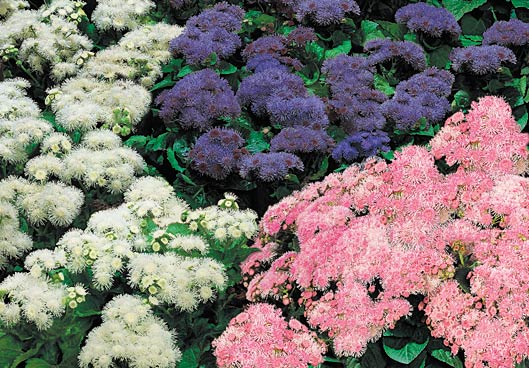 Thompson & Morgan
Thompson & Morgan
‘Hawaii Mix’
Ageratum houstonianum (a-jer-AY-tum)
Common name: Floss flower
Plant type: Annual
Plant size: Height: 6-24 inches
Width: 6-12 inches
Habit: Most are compact and mound-forming
Flower color: Blue, light blue, violet, pink, white
Flower size: Clusters of small flower heads, 2-4 inches across
Bloom period: Summer until frost
Leaf color: Green
Leaf size: 2-3 inches long, oval-shaped
Light: Full to part sun.
Soil: Well-drained, fertile. Also tolerates poor, infertile soil once established.
Uses: Low maintenance bedding plant; edging plant for borders; containers; taller varieties suitable
for perennial beds
Companion plants: Begonias, marigolds, petunias, Rudbeckias
Remarks: Drought tolerant; rarely requires deadheading; susceptible to early frosts, wait until mid
to late May to plant.

